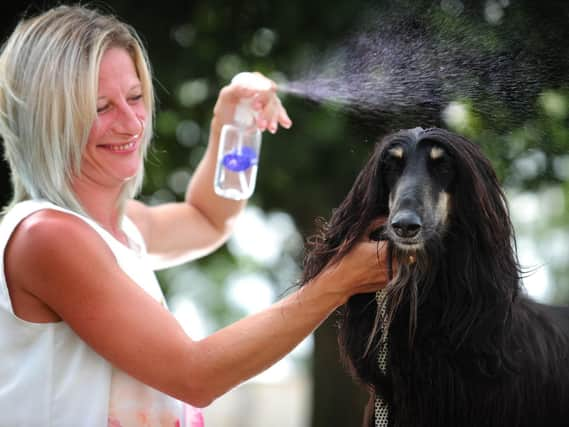Never leave dogs in vehicles, check for early signs of heatstroke, close curtains: Tips from Yorkshire canine experts on how to protect your dog from a heatwave and thunderstorms


With today’s peak temperature at 28C and another hot day tomorrow (July 23) at 24C, our four-legged friends are in for a difficult few days.
The experts have collated a list of protective measures for your dog to protect them from hot temperatures.
“Your dogs don’t need a walk every day. No dog has ever died from missing one walk,” said Dominique Armitage Riley, veterinary physiotherapist at Yorkshire Animal Therapy.
“If it’s too hot outside then don’t walk them. An alternative to walking, which tires them out just as much if not even more, is scent work.
“I usually refer my clients to a canine scent work instructor but you can also do DIY activities; grab some recycling (a cardboard box), punch some holes in it and hide their food or treats in it using packing paper or newspaper to slow them down.”
Just like with humans, dogs can be very intolerant to the heat, it can even endanger their lives if owners don’t take necessary precautions.
Davina Hinde, veterinary surgeon at Bainbridge Vets, based in Leyburn, discusses very important tips to protect your dog, including looking out for early signs of heatstroke.
“Dogs may struggle to keep cool in these hot temperatures, especially brachycephalic (flat-faced) breeds such as pugs and French bulldogs, older dogs and dogs with existing conditions such as heart problems,” she said.
“Some lighter coloured or fine fur dogs and cats can benefit from sun cream on their ear tips. Some tips to keep pets safe as the temperature rises: make sure your animal always has plenty of fresh drinking water.
“Make sure adequate ventilation is available at all times, avoid exercising your dog in the heat of the day, provide shade from the sun, especially in the hottest parts of the day, watch out for early signs of heatstroke such as heavy panting, restlessness and lack of coordination.
“Never leave dogs in vehicles, ’not long’ can be too long and if your animal is not cooling down or if you are at all concerned contact your vet immediately.”
According to Net Weather, there is a 42 per cent risk of thunderstorms on Monday. Gretta Ford, a clinical animal behaviourist at The Pitter Patter of Tiny Paws, talks about the many things you can do to protect your dog from thunderstorms.
“If your dog is worried by thunderstorms (or if you’re unsure) try to plan ahead and prepare some filled kongs or buy a stash of tasty chews which can keep them busy and distracted when needed,” she said.
“Close the curtains to block out the flashes and put the TV or the radio on to block out some of the sound.
“Offer them a safe place to go if they want to take themselves off somewhere. Some dogs might choose to go under a table or in their crate, or even an empty bath/open washing machine! Never close your dog in somewhere (even their crate) when they’re worried though - they need to be able to get out if they want to.
“Avoid taking your dog out for a walk - even out to the garden - when you know there will be flashes and rumbles. Some dogs may run off to escape and others become scared of going out in the garden again in the future because of negative associations.
“It’s fine to reassure your dog if they come to you for comfort (contrary to popular belief, you won’t reinforce the fear). Give them the comfort they need and then try to engage them in a fun activity if you can.
“Never punish your dog for barking or showing signs of being afraid during a storm - it won’t help and might well make things worse.
“If your dog really struggles, you could speak to your vet about a supplement or prescription medication for future events and consult with an ABTC accredited behaviourist to support you.”